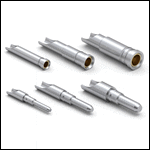How to Specify M-Style Sensor Connectors
M-style connectors come in various forms and sizes. Binder explains how to specify M-style connectors and the benefits of using an industry-standard connector.
 M-style connectors are a standard connecting solution for sensors and actuators in industrial network applications. They are designed to withstand harsh environments while providing reliable data and power transmission to automated machinery. Using an industry-standard connector simplifies sourcing the connectors from suppliers for new projects and ensures replacements are readily available, which can significantly reduce production downtime.
M-style connectors are a standard connecting solution for sensors and actuators in industrial network applications. They are designed to withstand harsh environments while providing reliable data and power transmission to automated machinery. Using an industry-standard connector simplifies sourcing the connectors from suppliers for new projects and ensures replacements are readily available, which can significantly reduce production downtime.
The M-style connectors are categorized by the size of the threaded locking nut; they include various sizes like the M5, M8, and M12 connectors. Contact arrangements in these styles can be three, four, five, eight, and 12 pins, most with IEC-compliant configurations.
The M12 standard (IEC 61076-2-101) and M8 standard (IEC 61076-2-104) were created to maintain a proper connection between components to offer a degree of protection against foreign debris, so that signal or power transmission cannot be compromised.
Although the M5 and M8 connectors are becoming popular because of their compact size, the M12 connector is still the most commonly used and offers many options for a complete solution for networking applications. The M12 standard was adopted by the automotive industry to supply a global standard interconnect solution that is consistent and reliable. These M-style connectors have increased factory automation and improved productivity by decreasing maintenance and downtime while improving the quality of the end product.
The M12 size is split into many styles based on the keying or shape of the contact body. A few styles include A-, B-, C-, D-, and X-coding; each coding style is used for different network protocols. Variations of the network data transmission include Profibus, IO-Link, Profinet, Ethernet, Ethernet/IP, CAN, and DeviceNet.
With standardization, it is very easy to determine the correct wiring for communication protocols, so there is no guesswork for the engineers. The connectors are all tested to the IEC standard to ensure they will provide a quality connection between multiple manufacturers. It is a huge advantage to the end-solution customers to have multiple manufacturers producing quality compatible connectors in a competitive market.
Some of the features available in an M-style connector include plastic and metal housing materials, EMI shielding, and straight and right-angle forms. Other options include field-installable versions, standard overmolded cordset lengths, and custom cordset solutions. They offer a degree of protection ranging from IP65 to IP69K, which means these connectors can be used in many environments.
M-style connectors have now found their way into just about every application and are the backbone of the automation, actuator, sensor, measurement, and robotic industries.
This article was contributed by Binder.





